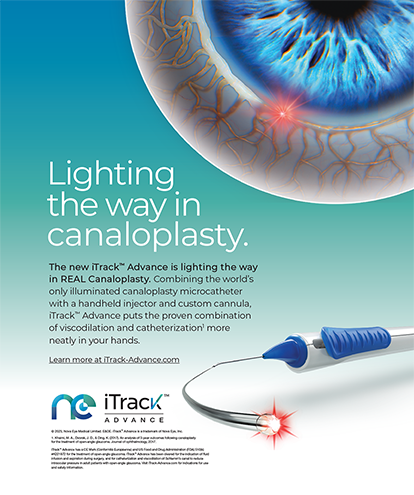CASE PRESENTATION
A 63-year-old white female presented to my office with decreasing vision in the right eye, 9 years after undergoing radial keratotomy. This patient's vision began to decline the year before she visited me. Her UCVA was 20/200 in the right eye and 20/50 in the left eye. Upon examination, her vision in the right eye could only be corrected to 20/50, with a refraction of -5.0 +2.0 X 20. The refraction in her left eye was +0.5 +0.5 X 155. This patient exhibited ocular changes due to nuclear sclerosis and wished to proceed with surgery in the right eye.
The data from this patient's previous surgery were available from our records. Before undergoing RK, her refraction was -5.5 + 0.5 X 45 OD and -5.25 +0.25 X 145 OS. Her keratometry readings were 47.5 X 180/48.5 X 90 OD and 47.0 X 35/48.25 X 125 OS. Her previous OD surgery had involved four incisions at an optical zone of 3.25 mm, followed at a later date by an enhancement involving four additional incisions at a 4.75-mm optical zone. All of these incisions spared the limbus. Following RK, the patient's refraction was -0.75 +1.0 X 30 OD and -0.50 sphere OS, and her keratometry readings were 43.37 X 25/43.75 X 115 OD and 43.25 X 20/43.87 X 118 OS.
HOW WOULD YOU PROCEED?1. What data would be helpful?
2. By what method would you determine the lens power?
3. What special concerns should be considered?
SURGICAL COURSE
I carefully counseled the patient about the risks of surgery as described later in this article. Next, I evaluated her corneal topography and corneal power by video keratography using the Holladay Diagnostic Summary on the EyeSys System 2000 (EyeSys Vision, Houston, TX), and found her effective refractive power to be 43.06 D. Using the historical method, which was possible because the patient's pre-RK data were available, I calculated her corneal power at 42.75 D. I determined this figure by subtracting the post-RK refraction (spherical equivalent) from the pre-RK refraction (spherical equivalent) and adding this figure to the pre-RK keratometry value. This method presumes that a stable refraction value is available before significant nuclear sclerosis changes take place.1 The patient's topography did not indicate increasing corneal astigmatic change, as one might have inferred by the refraction. Two technicians performed and confirmed immersion A-scan and calculated the IOL power using the Holladay II formula. Additionally, I targeted a slight myopic correction (-0.8 D) for the patient's postoperative refraction. My staff and I compared separate lens calculations for both the historical and video keratography values to ensure greater accuracy.
OUTCOME
After instilling viscoelastic (Figure 1), I performed phacoemulsification under topical anesthesia using a 2.8-mm clear corneal incision (Figure 2). Because the RK incisions spared the limbus, they were not invaded by the cataract surgery or lens implantation. I then implanted an MA60AT AcrySof acrylic foldable IOL (Alcon Laboratories, Fort Worth, TX) through a 3.2-mm incision (Figures 3 and 4). The patient's vision stabilized at 1 month, and her current visual acuity is 20/30 uncorrected in the right eye, with a refraction of -0.72 +1.0 X 40. I last examined her 3 months ago, and she is quite happy with her outcome.
DISCUSSION
The surgeon must address several concerns in preparing for cataract surgery following a refractive procedure. The informed consent should make clear that lens power calculations are less precise in these cases. In addition, patients should be made aware that secondary procedures, such as an IOL exchange or a piggyback lens placement, may be necessary. Refractive patients undergoing cataract surgery must also understand that their eyes may take longer to achieve visual stability.
Surgeons should be aware that applanating an altered cornea to obtain axial length measurements can potentially cause error in a case such as this. Using an immersion scan technique, which is my preferred method in all cases, will eliminate this possibility (as would using the IOL Master; Zeiss Humphrey Systems, Dublin, CA).
Accurate corneal power can be difficult and frustrating to measure due to changes of the corneal curvature profile. The most common error is to overestimate the corneal power, resulting in residual hyperopic refraction. Manual keratometry readings measure corneal power at a 3-mm optical zone, which is steeper than the true visual axis after RK. Computerized video keratography is more accurate when a mean effective power is given for the central 3 mm of the cornea, as in the EyeSys System 2000. The surgeon may use a contact lens overrefraction method for calculation in some cases if the patient's vision allows. The most reliable method is a calculated K reading derived from historical data, and comparing two or more of these methods will increase the surgeon's level of confidence.
Another challenge for cases such as these is determining the phaco incision style and placement. How many RK incisions are there? Do they extend into the limbus? Is there adequate space for a clear corneal incision, or should the surgeon use a scleral incision? Also, a previous radial incision may open, requiring suturing, regardless of the placement of the cataract incision. The surgeon should be prepared to address this complication.
Finally, I believe that the IOL type should be chosen to minimize capsule opacification. I recommend an acrylic or newer generation silicone lens. I urge caution in considering a multifocal IOL, because they can create difficulty in obtaining precise power calculations.
CONCLUSION
This case was successful in that all data from the patient's previous surgery were available and the outcome was very satisfactory. Surgeons are certain to encounter the post-refractive cataract patient more frequently as years pass. As with any complicated surgical situation, careful planning for special concerns will be the primary safeguard against undesired outcomes.
1. Hoffer K: Calculating intraocular lens power after refractive corneal surgery (editorial). Arch Ophthalmol. 2002;120;500-501.


